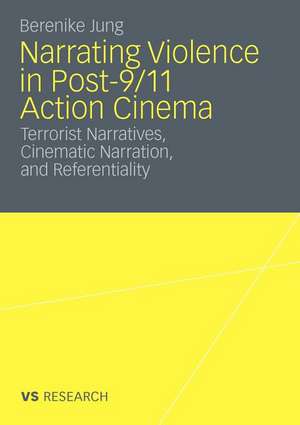Narrating Violence in Post-9/11 Action Cinema: Terrorist Narratives, Cinematic Narration, and Referentiality
Autor Berenike Jungen Limba Engleză Paperback – 30 sep 2010
Preț: 377.57 lei
Nou
Puncte Express: 566
Preț estimativ în valută:
72.25€ • 78.72$ • 60.88£
72.25€ • 78.72$ • 60.88£
Carte tipărită la comandă
Livrare economică 23 aprilie-07 mai
Preluare comenzi: 021 569.72.76
Specificații
ISBN-13: 9783531175102
ISBN-10: 3531175106
Pagini: 130
Ilustrații: 130 p.
Dimensiuni: 148 x 210 x 15 mm
Greutate: 0.17 kg
Ediția:2010
Editura: VS Verlag für Sozialwissenschaften
Colecția VS Verlag für Sozialwissenschaften
Locul publicării:Wiesbaden, Germany
ISBN-10: 3531175106
Pagini: 130
Ilustrații: 130 p.
Dimensiuni: 148 x 210 x 15 mm
Greutate: 0.17 kg
Ediția:2010
Editura: VS Verlag für Sozialwissenschaften
Colecția VS Verlag für Sozialwissenschaften
Locul publicării:Wiesbaden, Germany
Public țintă
ResearchCuprins
Narrating Violence - Violent Spectacle in Action Movies - Spectatorship: Engagement/Voyeurism, Watching Violence - Terrorist Movies - Just War Theory, Just Violence - Post-9/11 Cinema - Abu Ghraib Images and Torture Scandal - Cultural Criticism of Post-9/11 - US Foreign Policy
Notă biografică
Berenike Jung studied Comparative Literature, Cinema, and North American Studies in Berlin, New York, and Paris. She works as a journalist and author with a focus on film and media.
Textul de pe ultima copertă
This work discusses the way in which action movies have responded to the visual and narrative challenge of depicting terrorist violence after 9/11, when the spectacular representation of terrorist violence – and by extension the consumers of these imagers – was considered as complicit behaviour. If terrorism is theatre, who goes to see the show? A close-reading of exemplary movies (V for Vendetta, Munich, and Children of Men) concentrates on three key aspects: How is terrorist violence justified, especially in comparison to other forms of violence? How is the audience implicitly positioned? And finally, what is the role and scope of the films’ visual short-cuts, iconic “real” images such as those from the Abu Ghraib prison? The results reaffirm popular movies' power of working through traumatic events as well as their capacity to articulate a valid political critique. Instead of inventing or preceding real acts of violence, cinema can document, witness, and encourage the spectator to explore unorthodox viewing positions and moral dilemma. This interdisciplinary work is addressed to students of Philosophy, the Humanities, Cinema, American, or Cultural Studies as well as to the interested public.
Caracteristici
Terrorist Narratives, Cinematic Narration, and Referentiality












